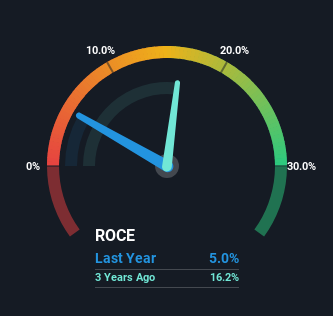- South Korea
- /
- Construction
- /
- KOSE:A001260
Namkwang Engineering & Construction (KRX:001260) Might Be Having Difficulty Using Its Capital Effectively

If you're not sure where to start when looking for the next multi-bagger, there are a few key trends you should keep an eye out for. One common approach is to try and find a company with returns on capital employed (ROCE) that are increasing, in conjunction with a growing amount of capital employed. Put simply, these types of businesses are compounding machines, meaning they are continually reinvesting their earnings at ever-higher rates of return. Having said that, from a first glance at Namkwang Engineering & Construction (KRX:001260) we aren't jumping out of our chairs at how returns are trending, but let's have a deeper look.
Return On Capital Employed (ROCE): What Is It?
If you haven't worked with ROCE before, it measures the 'return' (pre-tax profit) a company generates from capital employed in its business. Analysts use this formula to calculate it for Namkwang Engineering & Construction:
Return on Capital Employed = Earnings Before Interest and Tax (EBIT) ÷ (Total Assets - Current Liabilities)
0.05 = ₩7.0b ÷ (₩399b - ₩258b) (Based on the trailing twelve months to March 2024).
Therefore, Namkwang Engineering & Construction has an ROCE of 5.0%. On its own, that's a low figure but it's around the 6.0% average generated by the Construction industry.
Check out our latest analysis for Namkwang Engineering & Construction

Historical performance is a great place to start when researching a stock so above you can see the gauge for Namkwang Engineering & Construction's ROCE against it's prior returns. If you'd like to look at how Namkwang Engineering & Construction has performed in the past in other metrics, you can view this free graph of Namkwang Engineering & Construction's past earnings, revenue and cash flow.
What Can We Tell From Namkwang Engineering & Construction's ROCE Trend?
On the surface, the trend of ROCE at Namkwang Engineering & Construction doesn't inspire confidence. Around five years ago the returns on capital were 20%, but since then they've fallen to 5.0%. However, given capital employed and revenue have both increased it appears that the business is currently pursuing growth, at the consequence of short term returns. And if the increased capital generates additional returns, the business, and thus shareholders, will benefit in the long run.
Another thing to note, Namkwang Engineering & Construction has a high ratio of current liabilities to total assets of 64%. This effectively means that suppliers (or short-term creditors) are funding a large portion of the business, so just be aware that this can introduce some elements of risk. Ideally we'd like to see this reduce as that would mean fewer obligations bearing risks.
The Bottom Line
Even though returns on capital have fallen in the short term, we find it promising that revenue and capital employed have both increased for Namkwang Engineering & Construction. And there could be an opportunity here if other metrics look good too, because the stock has declined 33% in the last five years. As a result, we'd recommend researching this stock further to uncover what other fundamentals of the business can show us.
One more thing to note, we've identified 2 warning signs with Namkwang Engineering & Construction and understanding these should be part of your investment process.
While Namkwang Engineering & Construction may not currently earn the highest returns, we've compiled a list of companies that currently earn more than 25% return on equity. Check out this free list here.
Valuation is complex, but we're here to simplify it.
Discover if Namkwang Engineering & Construction might be undervalued or overvalued with our detailed analysis, featuring fair value estimates, potential risks, dividends, insider trades, and its financial condition.
Access Free AnalysisHave feedback on this article? Concerned about the content? Get in touch with us directly. Alternatively, email editorial-team (at) simplywallst.com.
This article by Simply Wall St is general in nature. We provide commentary based on historical data and analyst forecasts only using an unbiased methodology and our articles are not intended to be financial advice. It does not constitute a recommendation to buy or sell any stock, and does not take account of your objectives, or your financial situation. We aim to bring you long-term focused analysis driven by fundamental data. Note that our analysis may not factor in the latest price-sensitive company announcements or qualitative material. Simply Wall St has no position in any stocks mentioned.
Have feedback on this article? Concerned about the content? Get in touch with us directly. Alternatively, email editorial-team@simplywallst.com
About KOSE:A001260
Namkwang Engineering & Construction
Namkwang Engineering & Construction Co., Ltd.
Excellent balance sheet with questionable track record.
Market Insights
Community Narratives




